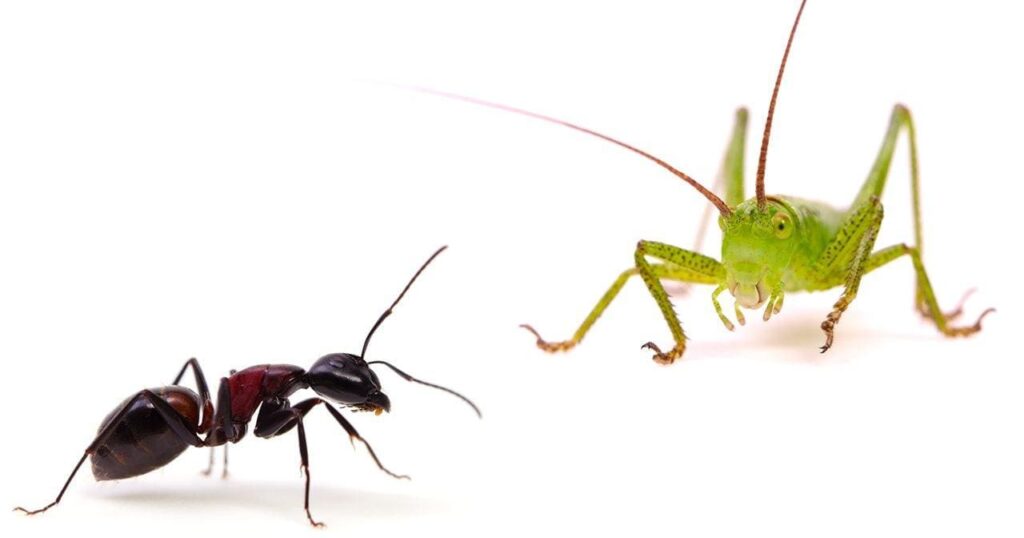
Grasshoppers and ants are two distinct types of insects that play important roles in their ecosystems. While both are commonly found in gardens and fields, they exhibit significant differences in their physical characteristics, behaviors, habitats, and ecological roles. Understanding these differences can enhance our appreciation for these fascinating creatures and help in managing them effectively in agricultural settings. This article explores the key distinctions between grasshoppers and ants.
Overview of Grasshoppers
Grasshoppers belong to the suborder Caelifera within the order Orthoptera. They are primarily herbivorous insects known for their powerful hind legs, which allow them to jump great distances. Grasshoppers are commonly found in grassy areas, fields, and gardens.
Physical Characteristics of Grasshoppers
- Size: Grasshoppers typically range from 0.5 to 4 inches (1.3 to 10 cm) in length.
- Color: They can be green, brown, or yellow, often with patterns that provide camouflage among vegetation.
- Body Structure: Grasshoppers have a long body with three main segments: head, thorax, and abdomen. They possess long antennae and large compound eyes.
- Wings: Many species have two pairs of wings; the forewings are narrow and leathery, while the hindwings are broader and membranous.
Overview of Ants
Ants belong to the family Formicidae within the order Hymenoptera. They are social insects known for their complex colonies and diverse behaviors. Ants can be found in various environments, including forests, deserts, and urban areas.
Physical Characteristics of Ants
- Size: Ants typically range from 1/16 to 2 inches (1.5 to 50 mm) in length, depending on the species.
- Color: Ants can be black, brown, red, or a mixture of these colors.
- Body Structure: Ants have three distinct body segments: head, thorax, and abdomen. They possess elbowed antennae and compound eyes.
- Wings: Winged ants have unequal-length wings; the forewings are larger than the hindwings.
Key Differences Between Grasshoppers and Ants
The following table summarizes the primary differences between grasshoppers and ants:
| Feature | Grasshoppers | Ants |
|---|---|---|
| Scientific Classification | Order Orthoptera, Suborder Caelifera | Order Hymenoptera, Family Formicidae |
| Body Segments | Three segments (head, thorax, abdomen) | Three segments (head, thorax, abdomen) |
| Antennae | Long and straight | Elbowed |
| Wings | Two pairs of wings | Two pairs of wings (unequal lengths) |
| Color | Green, brown, or yellow | Black, brown, red |
| Diet | Herbivorous; primarily feeds on plants | Omnivorous; feeds on various foods |
| Social Structure | Mostly solitary | Highly social; live in colonies |
| Lifespan | Several months | Varies by caste; workers live up to a year or more |
Behavioral Differences
Feeding Habits
Grasshoppers are primarily herbivorous insects that feed on a variety of grasses and leaves. They use their strong mandibles to chew through tough plant material. Their feeding habits can sometimes lead to significant damage in agricultural fields if populations become too large.Ants exhibit a more diverse diet as omnivores. They forage for food that includes seeds, nectar, fungi, other insects, and even human food scraps. Some ant species engage in mutualistic relationships with aphids or other insects for honeydew.
Social Behavior
Grasshoppers are generally solitary creatures. While they may congregate during mating seasons or when food is abundant, they do not form structured colonies like ants do.Ants are highly social insects that live in organized colonies consisting of queens, workers, and males. Each caste has specific roles within the colony—workers gather food, care for the young, and defend the nest while queens reproduce.
Habitat Preferences
Grasshopper Habitats
Grasshoppers thrive in open fields, meadows, grasslands, and gardens where they have access to ample vegetation for feeding. They prefer sunny environments where they can bask in the sun.
Ant Habitats
Ants can be found in a wide range of habitats including forests, grasslands, deserts, and urban areas. They build nests underground or within wood structures. Some species create elaborate mounds above ground.
Ecological Roles
Both grasshoppers and ants play essential roles in their ecosystems:
- Grasshoppers: As herbivores, grasshoppers contribute to plant control by feeding on foliage. Their feeding habits can influence plant community dynamics and nutrient cycling within ecosystems.
- Ants: Ants serve as important decomposers by breaking down organic matter and contributing to soil aeration through their tunneling activities. They also play roles as predators of pests and as seed dispersers for various plants.
Conclusion
In conclusion, while grasshoppers and ants may appear similar at first glance due to their insect classification and habitats they occupy, they exhibit significant differences in physical characteristics, behaviors, diets, social structures, and ecological roles. Understanding these distinctions is crucial for effective pest management strategies in agricultural settings.Recognizing whether you are dealing with a grasshopper or an ant infestation can lead to more informed decisions regarding control methods. Whether you need to manage grasshopper populations that threaten crops or address ant colonies invading your home or garden, knowing the differences between these two insects will help you take appropriate action for effective pest control solutions.





